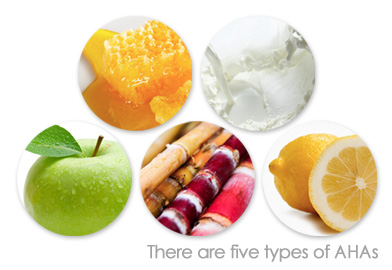- home ›
- Ingredient Highlights ›
- By Topic

Alpha hydroxy acids (AHAs) are mild acids that help the skin shed its outer layers of dead skin cells more efficiently, thereby stimulating cell turnover and skin renewal. There are five types of AHAs: glycolic acid (honey or sugarcane), lactic acid (milk), malic acid (apples and pears), citric acid (lemons and oranges), and tartaric acid (grapes). Most AHAs used in cosmetics are glycolic or lactic acids. Glycolic acid is the most researched AHA and reportedly works more effectively than other AHAs. Studies have shown that AHAs can improve skin texture and color and help boost collagen production. AHAs also improve skin hydration.
AHAs can increase sun sensitivity. So sun protection is very important when using AHAs. In May 2009, the FDA published a study in the Journal of Dermatological Science that evaluated sun sensitivity of the two most commonly used acids in cosmetics: glycolic acid and salicylic acid. The results showed that topical glycolic acid (10%) increased sun sensitivity as measured by all three UV response indices used in the study: sunburn cell formation, DNA damage, and erythema. Interestingly, the study showed that salicylic acid (2%) did not increase skin's sun sensitivity.
According to the Cosmetic Ingredient Review (CIR) Expert Panel - the American cosmetic industry's self-regulatory body for reviewing safety of cosmetic ingredients, AHAs are safe for home use in concentrations of less than 10% and with a pH of 3.5 or greater.
When choosing an AHA product, make sure the concentration is at least 4% and that the pH is between 3.5 and 5. If the pH value is too high (too alkaline), the exfoliating acids are neutralized and thus become ineffective. If it is too low (too acidic), the product will sting and irritate the skin. People with very sensitive or fragile skin should not use AHAs.
Updated: 5/11/2011
References:
Goldberg D, Herriott E. Secrets of Great Skin:the Definitive Guide to Anti-Aging Skin Care. New York,NY:Innova Publishing, 2004.
Michalum N, Michalun W. Milady's Skin Care & Ingredients Dictionary. New York:Cengage Learning, 2001.
Winter R. A Consumer's Dictionary of Cosmetic Ingredients. New York:Three Rivers Press, 2005.
Bergstrom KG. Beyond tretinoin: cosmeceuticals for aging skin. J Drugs Dermatol. 2009 Jul;8(7):674-7
Kornhauser A, Wei RR, Yamaguchi Y, et al. The effects of topically applied glycolic acid and salicylic acid on ultraviolet radiation-induced erythema, DNA damage and sunburn cell formation in human skin. J Dermatol Sci. 2009 Jul;55(1):10-7
